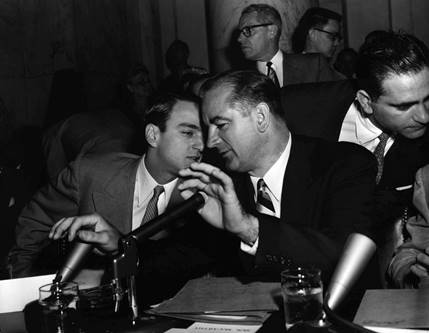The Cold War
(1945 - 1991)
Fears in American Society

Figure 1McCarthy, Joseph; Red
Scare Image. Britannica LaunchPacks, Encyclopedia Britannica, 8 Feb.
2020.
U.S. Senator Joseph McCarthy (covering microphone) during an
investigation into communist infiltration of the government.
The Second
Red Scare and McCarthyism reflected Cold War fears in American society.
Content Elaborations
1.
The actions of the Soviet
Union in Eastern Europe and the spread of communism in Asia caused a Second Red
Scare. These developments sparked fears among many Americans and challenged
civil liberties. The Second Red Scare focused attention on the media, labor
unions, universities, and the military as targets of communist subversion.
2.
Fears of subversion and
charges of communist infiltration of the U.S. government led to the following
actions:
a.
McCarthyism;
b.
investigations of the House
Un-American Activities Committee (HUAC); and
c.
blacklisting of suspected
communists.
Let’s Practice: Key Terms
|
|
The actions
of the Soviet Union in Eastern Europe and the spread of communism in Asia
sparked fears among many Americans. A second Red
Scare focused attention on the media, labor unions, universities, and
other organizations as targets of communist subversion.
Like the
first Red Scare following World War I, civil liberties were
again challenged. The investigations of the House Un-American Activities
Committee (HUAC) prompted employers to blacklist suspected communists,
including actors and writers.
The
beginning of the Second Red Scare is said to have begun in 1947. President
Harry Truman signed Executive Order 9835: sometimes called the “Loyalty Order,” it created the Federal
Employees Loyalty Program or the Loyalty Review Board. Its purpose was to investigate
the background of current and possible Federal Government employees.
HUAC, the House Un-American
Activities Committee, came to the forefront of the Second Red Scare. HUAC was made up of members of Congress.
Ø Investigated people alleged to have communist ties
Ø “Hollywood Blacklist” à actors and writers who
refused to cooperate
Wisconsin Senator Joseph McCarthy played a big part in the Second Red Scare. His
frequent and often questionable accusations of communists within the Federal
Government- a period and tactic that became known as McCarthyism- made him a
media sensation -as well as an outcast- across the country.
Let’s Practice: Matching
Columns Game
Section B: McCarthyism
|
|
On February
9, 1950, Wisconsin Senator Joseph
McCarthy made a speech to the Republican Women’s Club in Wheeling, West
Virginia, in which he accused members of the U.S. Department of
State of being communists. The so-called “Wheeling speech” launched a
period of “McCarthyism”—a “Red Scare” that did not end until the late 1950s.
McCarthyism targeted individuals
for having socialist or communist sympathies. The Soviet Union,
the Cold War enemy of the United States, had a communist
economy. People accused of being communists were suspected of being
disloyal to the U.S.
Thousands of
teachers, writers, union supporters,
and government employees were “blacklisted”
and lost their jobs after being accused of supporting communism. Celebrities,
too, were charged, including musician Leonard Bernstein, civil
rights activist W.E.B. DuBois, and physicist Robert
Oppenheimer.
Today, McCarthyism is defined as “the practice
of making accusations of disloyalty, often without proof or based on slight,
doubtful, or irrelevant evidence.”
Let’s Practice: Fill in
the Blanks Game

